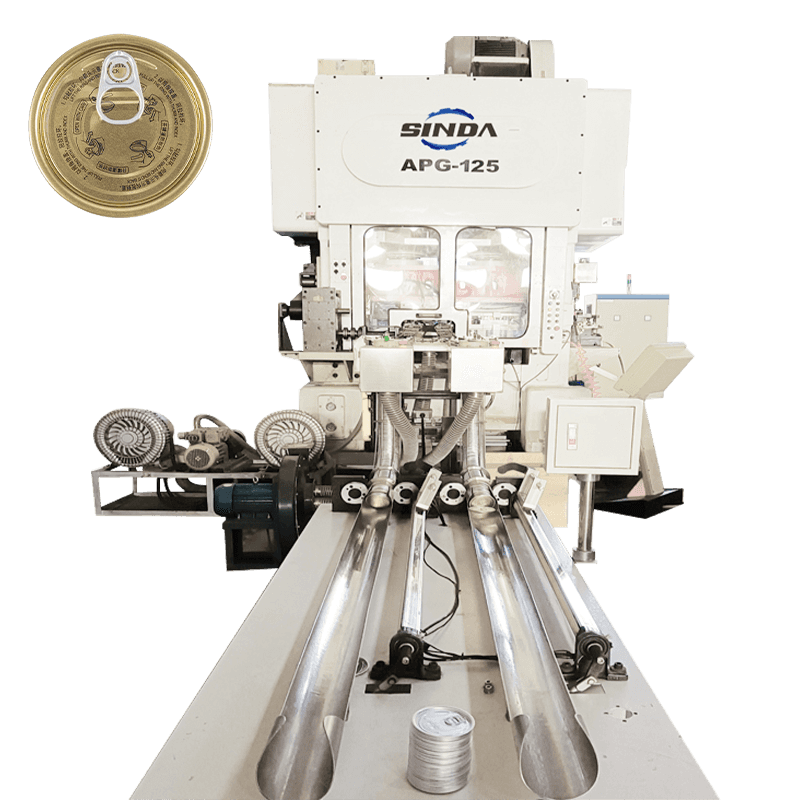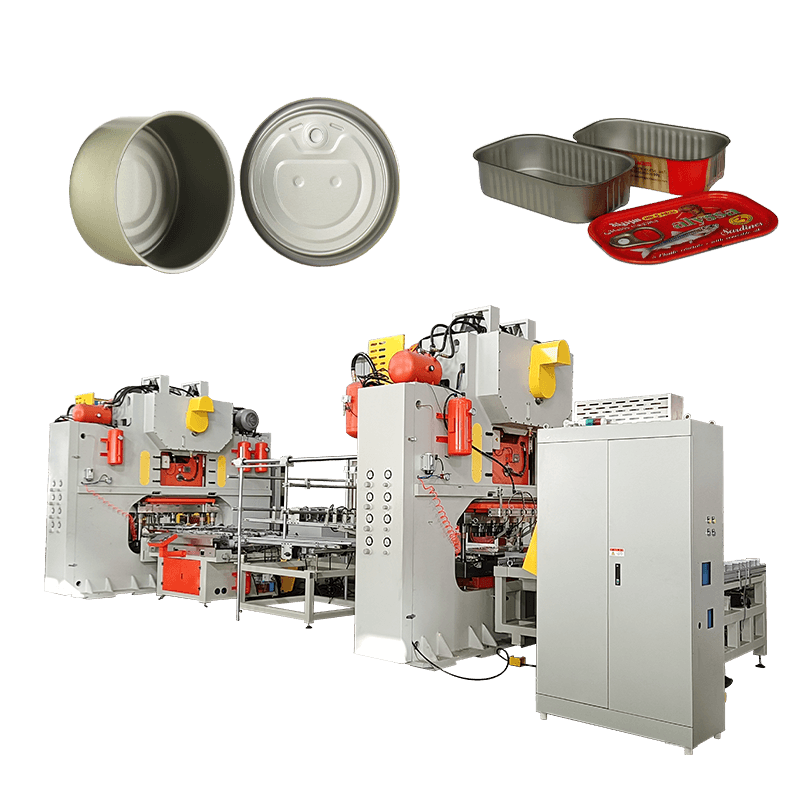Introduction to Semi-Automatic Can-Making Machines
Semi-automatic can-making machines are a key innovation in the manufacturing of metal cans, commonly used for packaging food, beverages, chemicals, and other consumer goods. These machines operate with a combination of manual and automated processes to form, shape, and finish cans. Compared to fully manual can-making methods, semi-automatic machines offer significant advantages in terms of efficiency, cost-effectiveness, and quality control. One of the primary benefits of these machines is their ability to reduce waste and improve resource utilization, making them a more sustainable option for manufacturers. This article explores how semi-automatic can-making machines contribute to waste reduction and better resource management in the manufacturing process.
How Semi-Automatic Can-Making Machines Work
Semi-automatic can-making machines are designed to streamline the can production process while still allowing for some level of manual input. Typically, these machines consist of multiple stages, including metal sheet feeding, blanking, body forming, necking, and seaming. While some operations are automated, others require the intervention of a skilled operator to ensure proper alignment, adjustment, and quality control. The level of automation in these machines can vary depending on the model and the specific needs of the manufacturer. However, the overall goal is to improve production speed and consistency while minimizing human error and material waste.
Reducing Material Waste through Precision
One of the most significant ways in which semi-automatic can-making machines reduce waste is through the precision with which they operate. Traditional manual can-making methods often involve a high degree of human error, which can lead to uneven cuts, misalignment of materials, and excess scrap. In contrast, semi-automatic machines are equipped with advanced sensors, automated feeding systems, and precise cutting tools that ensure the materials are used efficiently. The machines can accurately measure the amount of metal required for each can, reducing excess material that would otherwise be discarded.
For example, during the blanking process, the machine cuts metal sheets into precise shapes that fit the can’s dimensions, minimizing the amount of scrap generated. Similarly, the body-forming and necking processes are designed to reduce excess metal, ensuring that each can is produced with minimal waste. The ability to control these stages with high precision ensures that the material is utilized effectively, reducing the need for rework or adjustments that could create additional waste.
Optimizing Resource Utilization through Automation
Semi-automatic can-making machines also improve resource utilization by automating several stages of the production process. Automation helps to maintain consistency and repeatability in production, which is essential for reducing material waste. Automated feeding systems, for example, allow the machine to continuously feed metal sheets into the production line, reducing the risk of material loss due to misfeeds or delays. Furthermore, automated quality checks can detect any defects or inconsistencies in the cans as they are produced, preventing substandard products from advancing to later stages of production and ultimately reducing the amount of scrap that needs to be discarded.
In addition, semi-automatic can-making machines are often equipped with adjustable settings that allow manufacturers to tailor the machine’s operations to different can sizes and materials. This flexibility helps optimize the use of resources by ensuring that the machine operates at peak efficiency for each specific product. By reducing setup time and minimizing the need for adjustments, manufacturers can optimize material usage and reduce the overall production cost.
Reducing Energy Consumption
In addition to reducing material waste, semi-automatic can-making machines can contribute to sustainability by lowering energy consumption. Fully automated machines may require more energy to run due to the complexity of their systems, whereas semi-automatic machines often use less power while still achieving high production rates. By integrating energy-efficient components, such as variable-speed motors and energy-saving technologies, semi-automatic machines help reduce the overall energy footprint of the can-making process. Lower energy consumption not only reduces operational costs but also minimizes the environmental impact of manufacturing operations.
Improving Production Efficiency and Reducing Downtime
Another way in which semi-automatic can-making machines contribute to waste reduction is by improving overall production efficiency. The combination of automation and manual control allows operators to quickly adapt the machine to different production needs without significant downtime. This reduced downtime translates into higher production rates and better resource utilization. The efficiency of the machine also ensures that cans are produced consistently and in large volumes, helping manufacturers meet demand without the need for excess inventory or production runs. By optimizing the production process, semi-automatic can-making machines contribute to the overall efficiency of the factory, allowing for the more effective use of both materials and labor.
Enhancing Scrap Management
Scrap management is a crucial aspect of reducing waste in any manufacturing process, and semi-automatic can-making machines help in this regard. These machines often come equipped with systems for handling scrap efficiently. For example, during the production process, scrap materials can be collected and fed back into the system for recycling. In many cases, semi-automatic machines allow manufacturers to sort and separate scrap based on its quality and type, ensuring that reusable materials are properly recycled and reintegrated into the production process. This closed-loop system helps to minimize the amount of waste that ends up in landfills while maximizing the use of valuable raw materials.
Cost Efficiency through Waste Reduction
Waste reduction through the use of semi-automatic can-making machines also translates into cost savings for manufacturers. By reducing the amount of material waste, manufacturers can lower their raw material costs, which makes the production process more cost-effective. The reduction in scrap not only saves money on materials but also on the disposal and recycling of waste. Furthermore, the efficiency of semi-automatic machines allows for better inventory management, reducing the need for excess raw materials and minimizing the cost of storing unused stock. All of these factors contribute to a more cost-efficient production process, which can improve the profitability of the manufacturer.
Comparison of Traditional and Semi-Automatic Can-Making Machines
| Aspect | Traditional Can-Making Methods | Semi-Automatic Can-Making Machines |
|---|---|---|
| Material Waste | Higher material waste due to manual processes and inconsistent cuts | Lower material waste with precise automated cutting and shaping |
| Production Speed | Slower production speed with longer setup times | Faster production speed with automated feeding and minimal setup time |
| Resource Utilization | Potentially inefficient use of resources due to manual handling | Improved resource utilization through automation and precise control |
| Energy Consumption | Higher energy consumption due to inefficient machinery | Lower energy consumption with energy-efficient components and systems |
| Scrap Management | Manual handling of scrap with potential for high wastage | Automated scrap collection and recycling systems to minimize waste |
| Cost Efficiency | Higher labor and material costs due to inefficiencies | Lower production costs with reduced waste and improved efficiency |
The Role of Semi-Automatic Can-Making Machines in Sustainable Manufacturing
Semi-automatic can-making machines play a crucial role in improving the sustainability of the can manufacturing process. By reducing material waste, optimizing resource utilization, lowering energy consumption, and enhancing overall production efficiency, these machines contribute to a more sustainable and cost-effective manufacturing process. Through improved precision and automation, manufacturers can produce high-quality cans with fewer resources, reducing their environmental impact while maintaining competitiveness in the market. As the demand for environmentally friendly manufacturing solutions grows, semi-automatic can-making machines will continue to be a valuable tool in achieving waste reduction and improving resource management in the can-making industry.

 English
English عربى
عربى русский
русский




